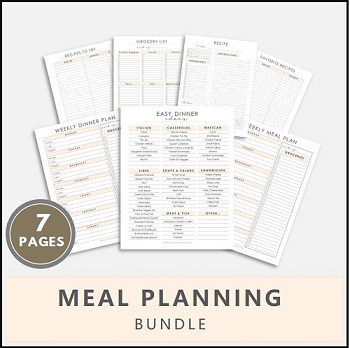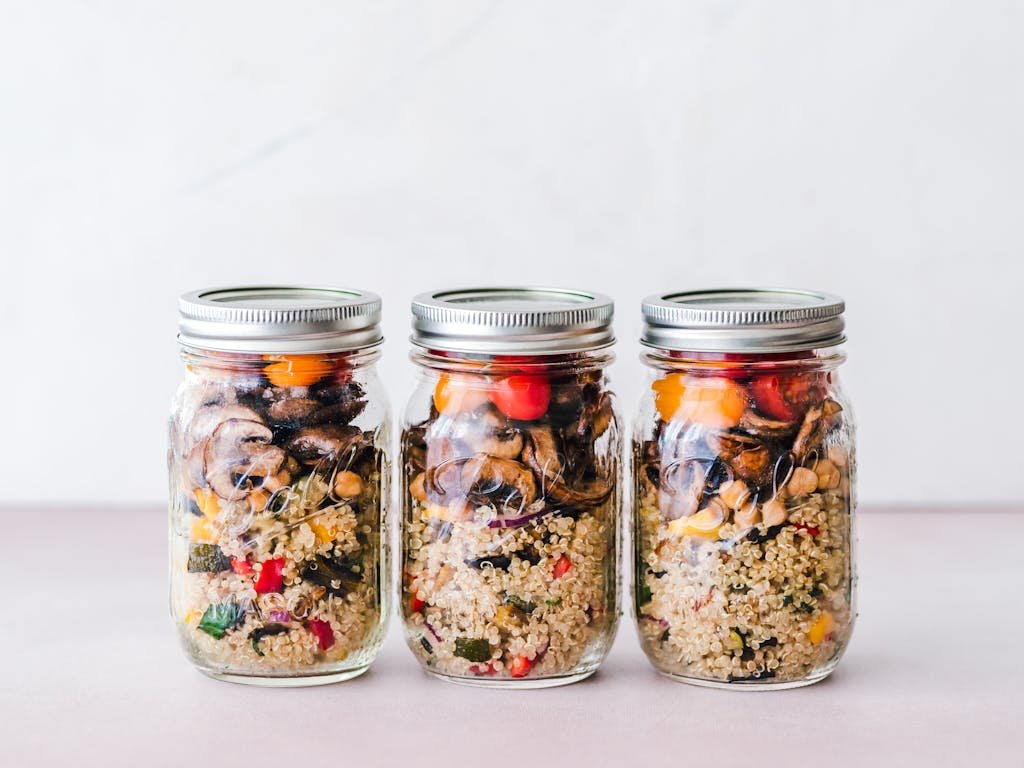Food Prep Ideas: Time-Saving Strategies for Busy Weeknights
Meal prepping can save you time, money, and mental energy throughout your busy week. By setting aside just a few hours on the weekend, you can prepare nutritious meals that are ready when you need them. Effective meal prep doesn’t have to be complicated—it’s simply about planning ahead and making smart choices that fit your lifestyle and dietary needs.
Looking for inspiration? Budget-friendly meal prep ideas are plentiful and can be adapted to suit your taste preferences. From baked chicken breast to sweet potato black bean skillets, the options are endless. You can start small by prepping just a few components like roasted vegetables, beans, or proteins that can be mixed and matched throughout the week.
Key Takeaways
- Meal prepping helps you save time and money while ensuring you have healthy options ready throughout the week.
- You can start with simple components like proteins, vegetables, and grains that can be combined in different ways.
- Planning your meals before shopping helps reduce food waste and keeps your prep sessions focused and efficient.
Essentials of Meal Prep
Good meal prep saves time and helps you eat healthier food throughout the week. The right containers and food safety knowledge form the foundation of successful meal prepping.
Choosing the Right Storage Containers
Selecting proper containers makes a big difference in your meal prep success. Look for BPA-free containers that are durable and the right size for your needs.
Glass containers with secure lids are excellent choices since they don’t absorb odors or stains. They’re also safe for reheating in the microwave.

Consider compartmentalized options if you prefer keeping foods separate. These are perfect for balanced meals with proteins, vegetables, and grains.
Silicone bags provide a flexible alternative to rigid containers. They take up less space when empty and are good for freezing portions.
For soups and stews, mason jars work well. Leave space at the top if freezing to allow for expansion.
Freezer trays are useful for storing individual portions of sauces, broths, or baby food.
Understanding Food Safety for Leftovers
Food safety is a key part of successful meal prep. Always cool hot foods before refrigerating them to prevent bacterial growth.
Most prepared meals stay fresh in the refrigerator for 3-5 days. Label containers with preparation dates to track freshness.
Freezing extends storage time to 2-3 months for most dishes. Some foods like soups freeze better than others such as meals with crispy components.

When reheating, make sure food reaches 165°F (74°C) throughout to kill any bacteria. Stir food halfway through heating for even temperature distribution.
Don’t leave perishable foods at room temperature for more than 2 hours. The risk of bacterial growth increases significantly after this time.
Consider meal prepping sturdy foods like roasted vegetables, grains, and proteins that hold up well over several days.
Crafting Your Weekly Meal Plan
Planning meals ahead saves time, reduces food waste, and helps you eat better. A good plan balances nutrition with foods you enjoy.
Incorporating Diverse Healthy Recipes
Start by choosing recipes that can be easily prepared and enjoyed throughout the week. Think about what you like to eat and what fits your schedule.
Mix up your meal options with these ideas:
- Breakfast: Smoothie bowls, overnight oats, or egg muffins
- Lunch: Grain bowls, hearty soups, or protein-packed salads
- Dinner: Sheet pan meals, stir-fries, or slow cooker dishes
- Snacks: Cut veggies with hummus, yogurt parfaits, or energy bites
Try to include at least one new recipe each week to prevent boredom. You can find budget-friendly meal prep ideas online that won’t break the bank.
Using A Meal Planning Printable
When you can plan out your meals for the entire week, you are likely not to overspend or overbuy at the grocery store.
Our meal planning printable include:
- Weekly Meal Planner
- Weekly Dinner Planner
- Grocery List
- Favorite Recipe List
- Recipes to Try
- 65 Easy Dinner Ideas List (pre-filled)
- Reading Log

Maximizing Nutrition with Healthy Ingredients
Fill your shopping cart with nutrient-dense foods to form the base of your meals.
Protein sources should include a mix of:
- Lean meats (chicken, turkey)
- Plant proteins (beans, lentils, tofu)
- Fish (salmon, tuna)
- Eggs
Complex carbohydrates provide lasting energy:
- Whole grains (brown rice, quinoa)
- Sweet potatoes
- Beans and legumes
Don’t forget healthy fats from avocados, nuts, seeds, and olive oil. Add plenty of colorful vegetables and fruits for vitamins, minerals, and fiber.
Read labels carefully to avoid added sugars and excessive sodium in packaged foods. The best healthy ingredients are often found along the perimeter of the grocery store.
Preparing Meals in Advance
Set aside 2-3 hours one day a week for meal prep. Sunday often works well for many people.
Start with “building block” components:
- Cook a large batch of grains
- Roast several trays of vegetables
- Prepare 1-2 protein sources
- Make a versatile sauce or dressing
- Wash and chop fruits for snacks
Store prepped foods in clear containers so you can see what’s available. Some meals can be fully assembled ahead of time, while others work better with components stored separately.

Foods like soups, stews, and casseroles often taste better after flavors have had time to blend. Salads stay fresh longer when you keep dressings separate until eating.
Your instant pot can be a huge time-saver for cooking beans, grains, and proteins.
Innovative Food Prep Ideas
A few smart meal prepping strategies can save you time and help you eat healthier throughout the week. These ideas combine convenience with nutrition to keep your meals interesting.
Creative Salads and Snacks
Mason jar salads are perfect for busy people. Layer ingredients with dressing at the bottom, followed by hearty vegetables, proteins, and greens on top to prevent sogginess. When ready to eat, just shake and enjoy.
Try preparing veggie sticks with hummus cups for quick snacks. Cut carrots, cucumbers, and bell peppers in advance and store them in water to maintain crispness.
Greek yogurt parfaits can be assembled with berries and a touch of honey. Store toppings like nuts and granola separately to add just before eating.
Chickpea salad is protein-rich and stays fresh for days. Mix with diced vegetables, feta cheese, and a simple olive oil dressing for a filling lunch option.
Time-Saving Instant Pot Recipes
The Instant Pot makes meal prepping much faster. Prepare a large batch of shredded chicken with salsa for tacos, bowls, and salads throughout the week.
Bean and grain bowls cook perfectly in the Instant Pot. Try:
- Brown rice and black beans (25 minutes)
- Quinoa and lentils (15 minutes)
- Barley and chickpeas (30 minutes)
Hard-boiled eggs become effortless—5 minutes at high pressure, then a quick release. They peel easily and provide protein for salads or quick snacks.
Soups and stews freeze well in single portions. Vegetable soup with beans or chicken and rice soup can be ready in under 30 minutes total cooking time.
Breakfast Options: Overnight Oats
Overnight oats require no cooking and can be prepared in batches. The basic formula uses 1:1 ratio of rolled oats to liquid (milk or plant-based alternative) plus your favorite mix-ins.
Popular flavor combinations:
- Apple cinnamon: diced apples, cinnamon, maple syrup
- Berry blast: mixed berries, vanilla extract, honey
- Chocolate banana: cocoa powder, sliced banana, nut butter
Store in small containers for grab-and-go breakfasts that last up to 5 days in the refrigerator. Add toppings like fresh fruit, nuts, or seeds just before eating.
For a protein boost, mix in Greek yogurt or protein powder. This simple adjustment turns your breakfast into a balanced meal that keeps you full until lunch.
Frequently Asked Questions
Meal prepping saves time and helps with portion control. These common questions address healthy options, weight management, quick recipes, protein sources, food storage, and family-friendly ideas.

What are some healthy vegetarian options for weekly meal prepping?
Plant-based meal prep offers many nutritious possibilities for your weekly routine. Buffet meal prep works well for vegetarian options, giving you flexibility to mix and match components.
Try preparing roasted vegetable batches with sweet potatoes, bell peppers, and zucchini. These can be added to grain bowls or wraps throughout the week.
Protein-rich legumes like chickpeas, lentils, and black beans can form the base of many meals. Cook a large batch to add to salads, soups, or buddha bowls.
Tofu and tempeh are excellent protein sources that absorb flavors well. Marinate and bake them ahead of time for quick meal assembly.
How can meal prepping aid in achieving weight loss goals?
Meal prepping gives you control over ingredients and portion sizes. When you prepare meals in advance, you’re less likely to make impulsive food choices when hungry.
Planning your meals helps you track calories and nutrients accurately. You can design each container with the right balance of protein, carbs, and healthy fats.
Having healthy options ready reduces the temptation to order takeout. When you’re tired after work, having a nutritious meal ready to heat makes the healthy choice the easy choice.
Batch cooking allows you to keep recipes simple while controlling salt, sugar, and fat content better than restaurant meals.
What are some easy and healthy meal prep ideas for a busy week?
Sheet pan meals save time with minimal cleanup. Combine protein and vegetables on one pan, season, and roast while you handle other tasks.
Overnight oats make breakfast prep effortless. Mix oats with milk or yogurt, add fruits and nuts, and refrigerate overnight for ready-to-eat morning meals.
Soup and chili recipes often taste better after a day or two. Make a large pot on Sunday to enjoy throughout the week.
Mason jar salads stay fresh for days when layered correctly. Put dressing on the bottom, add hearty vegetables, then greens on top to prevent wilting.
Can you suggest some high-protein meal prep recipes?
Egg muffins pack protein into a portable breakfast option. Mix eggs with vegetables, cheese, and lean meat before baking in a muffin tin.
Greek yogurt parfaits with nuts and seeds offer complete proteins. Layer them with fruit for a quick breakfast or snack.
Chicken and turkey breast can be cooked in batches and added to various meals. Season differently to avoid monotony in your weekly menu.
Salmon and tuna meal prep well for 2-3 days. Pair with quinoa and vegetables for a complete high-protein meal that reheats nicely.
Bean and lentil soups provide plant-based protein that improves with time. They freeze well for longer storage options.
How do you safely store prepped meals for optimal freshness?
Choose appropriate containers for different food types. Glass containers work well for most foods, while specialized containers help keep salads crisp.
Refrigerate meals properly to maintain safety. Most prepped meals last 3-5 days when stored at the correct temperature.
Freeze portions you won’t eat within a few days. Label with dates and contents to track what needs to be used first.
Store ingredients separately when possible. Keep dressings, sauces, and crunchy toppings apart until ready to eat to maintain textures.
What are some quick dinner meal prep ideas for family meals?
Casseroles work wonderfully for family meal prep. Assemble ahead and either refrigerate or freeze until you’re ready to bake.
Slow cooker recipes require minimal hands-on time. Prepare ingredients the night before, then start cooking in the morning for a ready dinner.
Batch-cooked proteins paired with pre-chopped vegetables make quick stir-fries possible. You can vary the sauces each night for different flavors.
Taco or burrito filling prepared in advance speeds up weeknight dinners. Family members can customize their own meals while you save time on cooking.